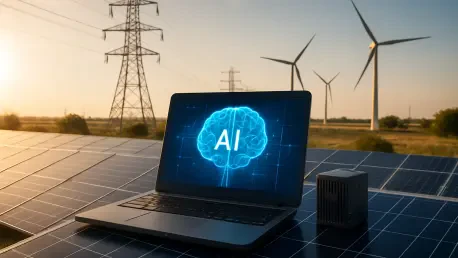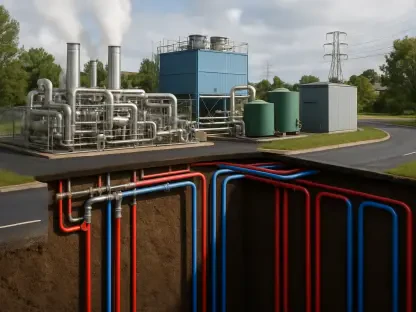Setting the Stage for a Smarter Energy Future
In an era where energy demands are skyrocketing and climate challenges loom large, the global utility sector faces an unprecedented need to transform aging infrastructure into a resilient, efficient system, especially as over 70% of grid components in many regions have exceeded their expected lifespan. The risk of outages and inefficiencies has never been higher. Artificial Intelligence (AI) emerges as a beacon of hope, promising to revolutionize grid modernization by harnessing data-driven insights and automation. This review delves into the transformative potential of AI in the utility sector, exploring its applications, real-world impacts, and the hurdles that stand in the way of widespread adoption.
The urgency for grid modernization is compounded by the rapid integration of renewable energy sources like solar and wind, which introduce variability into power systems. AI offers tools to manage this complexity, enabling utilities to predict demand, optimize distribution, and maintain stability. Beyond technical solutions, the technology aligns with broader digital transformation trends in the energy industry, positioning itself as a cornerstone of innovation. This analysis aims to unpack how AI is reshaping grid operations while shedding light on the barriers that must be addressed to unlock its full potential.
Core Principles and Drivers of AI in Grid Modernization
At its heart, AI in grid modernization leverages machine learning, predictive analytics, and automation to enhance decision-making and operational efficiency. Machine learning algorithms analyze vast datasets from grid sensors and historical records to identify patterns, while predictive analytics forecasts potential issues before they escalate. Automation, meanwhile, streamlines repetitive tasks such as fault detection, reducing human error and response times. Together, these capabilities empower utilities to shift from reactive to proactive management of energy systems.
The adoption of AI is driven by critical challenges facing the sector, including deteriorating infrastructure and rising energy consumption. Many grid components, installed decades ago, struggle to meet modern demands, leading to frequent disruptions. Simultaneously, the push for sustainability has accelerated the use of renewables, necessitating advanced tools to balance intermittent supply with fluctuating demand. AI’s ability to address these issues makes it a vital asset in ensuring reliability and supporting environmental goals.
In the broader technological landscape, AI fits seamlessly into the utility sector’s digital transformation journey. It complements other innovations like smart meters and Internet of Things (IoT) devices, creating a connected ecosystem where data is key. As utilities prioritize modernization over generic digital upgrades, AI stands out as a targeted solution for tangible outcomes, paving the way for a smarter, more adaptive energy grid.
Key Applications Transforming Grid Operations
Predictive Maintenance and Asset Management
One of AI’s most impactful roles lies in predictive maintenance, where it analyzes data from grid equipment to anticipate failures before they occur. By monitoring variables like temperature, vibration, and wear, AI models can pinpoint when components are likely to break down, allowing utilities to schedule repairs during off-peak times. This approach minimizes unplanned outages, a persistent issue with aging infrastructure, and significantly cuts maintenance costs.
Beyond immediate fixes, AI enhances asset management by extending the lifespan of critical infrastructure. It prioritizes interventions based on risk assessments, ensuring resources are allocated efficiently. For utilities grappling with limited budgets and widespread deterioration, this data-driven strategy is a game-changer, bolstering grid reliability and reducing the financial burden of reactive repairs.
Renewable Energy Integration and Demand Forecasting
AI also plays a pivotal role in integrating renewable energy into the grid, addressing the unpredictability of sources like solar and wind. Through sophisticated forecasting models, it predicts energy production based on weather patterns and historical data, enabling utilities to balance supply with demand. This capability is essential for maintaining grid stability as renewable penetration grows.
Additionally, AI refines demand forecasting by analyzing consumer behavior, seasonal trends, and economic factors. Accurate predictions help utilities optimize energy distribution, avoiding overproduction or shortages. As the energy mix evolves, this application of AI ensures a smoother transition to sustainable power systems, supporting both operational efficiency and environmental targets.
Emerging Patterns in AI Adoption Among Utilities
Recent industry surveys reveal a growing consensus that AI is the most influential technology for utility innovation in the coming years. A significant shift in focus places grid modernization at the forefront, with over 70% of utility leaders ranking it among their top priorities, surpassing broader digital transformation initiatives. This trend reflects a strategic pivot toward addressing specific infrastructure challenges with cutting-edge tools.
Another notable pattern is the emphasis on measurable results from AI investments. Utilities are zeroing in on metrics like cost savings, operational efficiency, and return on investment to justify adoption. This pragmatic approach underscores a maturing perspective in the sector, where innovation must deliver clear financial and performance benefits to gain traction.
Collaboration with external partners, particularly AI startups, is also on the rise as utilities seek to overcome internal limitations. These partnerships provide access to specialized expertise and innovative solutions, bridging gaps in knowledge and technology. While cultural differences pose challenges, the trend toward external alliances highlights an industry eager to accelerate its modernization efforts through shared resources.
Real-World Impacts and Case Studies
AI’s practical value shines through in diverse applications across the utility sector. For instance, some companies have deployed AI to mitigate wildfire risks by analyzing environmental data and identifying high-risk areas for preemptive action. Others have enhanced worker safety by using AI to detect hazardous conditions in real time, preventing accidents during grid maintenance.
Cybersecurity is another area where AI is making a mark, with utilities employing algorithms to detect and respond to digital threats faster than traditional methods. Survey data indicates that 42% of utility leaders plan to implement AI solutions by 2027, showcasing a strong commitment to leveraging the technology for such critical needs. These examples illustrate AI’s ability to address multifaceted challenges in energy systems.
Pilot programs further demonstrate AI’s potential, with certain utilities testing demand response systems powered by AI to optimize energy usage during peak times. These initiatives not only improve grid efficiency but also provide valuable insights for scaling AI applications. Such real-world deployments underscore the technology’s capacity to deliver actionable solutions tailored to specific operational pain points.
Obstacles Hindering AI Implementation
Despite its promise, AI adoption in the utility sector faces significant hurdles, chief among them a lack of internal expertise. Survey findings reveal that 61% of utility leaders identify talent shortages as a primary concern, hampering the ability to develop and deploy AI solutions effectively. This skills gap creates a bottleneck, slowing the pace of innovation in an industry already under pressure to modernize.
Technical and cultural challenges compound the issue, particularly when implementing specialized tools like small language models designed for utility-specific tasks. These solutions require nuanced understanding and customization, which many organizations struggle to achieve internally. Resistance to change within traditional utility structures further complicates the integration of advanced technologies.
Partnerships with startups, while promising, are not without friction. Cultural mismatches between established utilities and agile tech firms can hinder collaboration, as differing priorities and workflows create tension. Efforts to address these barriers through targeted training programs and strategic alliances are underway, but overcoming them demands sustained commitment and adaptability from all parties involved.
Future Prospects for AI in Energy Systems
Looking ahead, AI’s trajectory in grid modernization appears poised for growth, with advancements in tailored solutions likely to drive broader adoption. Innovations such as industry-specific algorithms and scalable platforms could lower the entry barrier for utilities, making AI more accessible. As these technologies mature, they promise to enhance the sector’s ability to manage complex energy challenges.
Addressing talent shortages remains a critical focus, with potential breakthroughs expected through expanded educational initiatives and policy support. Collaborations between academic institutions, governments, and utilities could cultivate a skilled workforce equipped to handle AI deployment. Such efforts are essential for building long-term capacity within the industry to sustain technological progress.
The long-term impact of AI on energy grids holds transformative potential, fostering resilience, sustainability, and efficiency. By enabling smarter resource allocation and supporting renewable integration, AI can play a central role in meeting global energy demands. Its evolution will likely shape a future where energy systems are not only more reliable but also aligned with pressing environmental imperatives.
Reflecting on AI’s Journey in Grid Modernization
Looking back, the exploration of AI in grid modernization reveals a technology with immense capacity to reshape the utility sector, from enhancing predictive maintenance to stabilizing renewable energy integration. Its real-world applications have already begun to address critical issues like wildfire prevention and cybersecurity, proving its versatility. Yet, the journey is not without obstacles, as talent shortages and cultural barriers slow progress despite widespread enthusiasm.
The path forward hinges on strategic actions to bridge existing gaps. Utilities must prioritize investments in workforce development, fostering expertise through training and partnerships with educational bodies. Simultaneously, deeper collaborations with AI startups, supported by frameworks to align cultural differences, can accelerate innovation. By focusing on these steps, the industry can harness AI’s full potential, ensuring energy grids evolve to meet modern challenges with resilience and efficiency.









